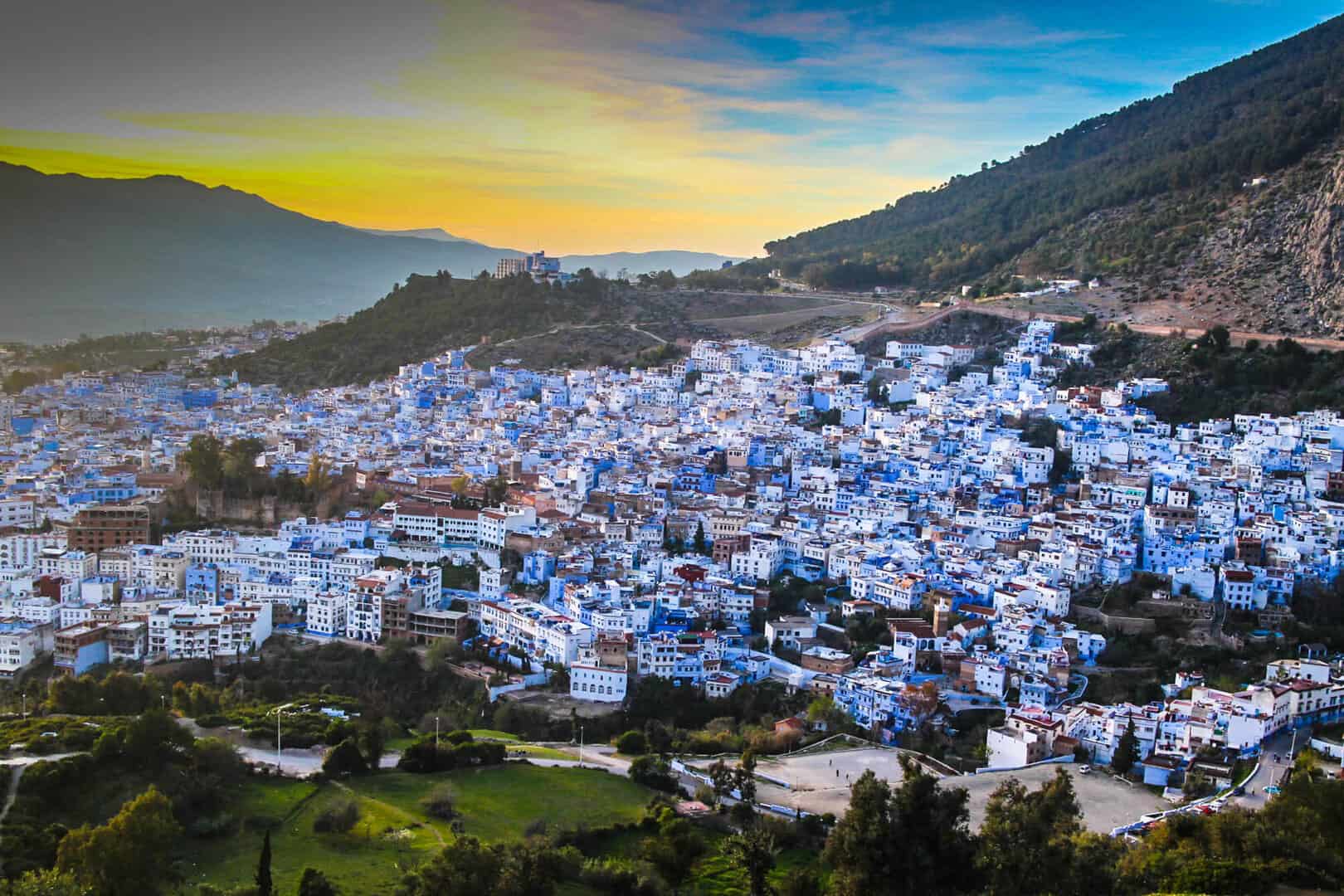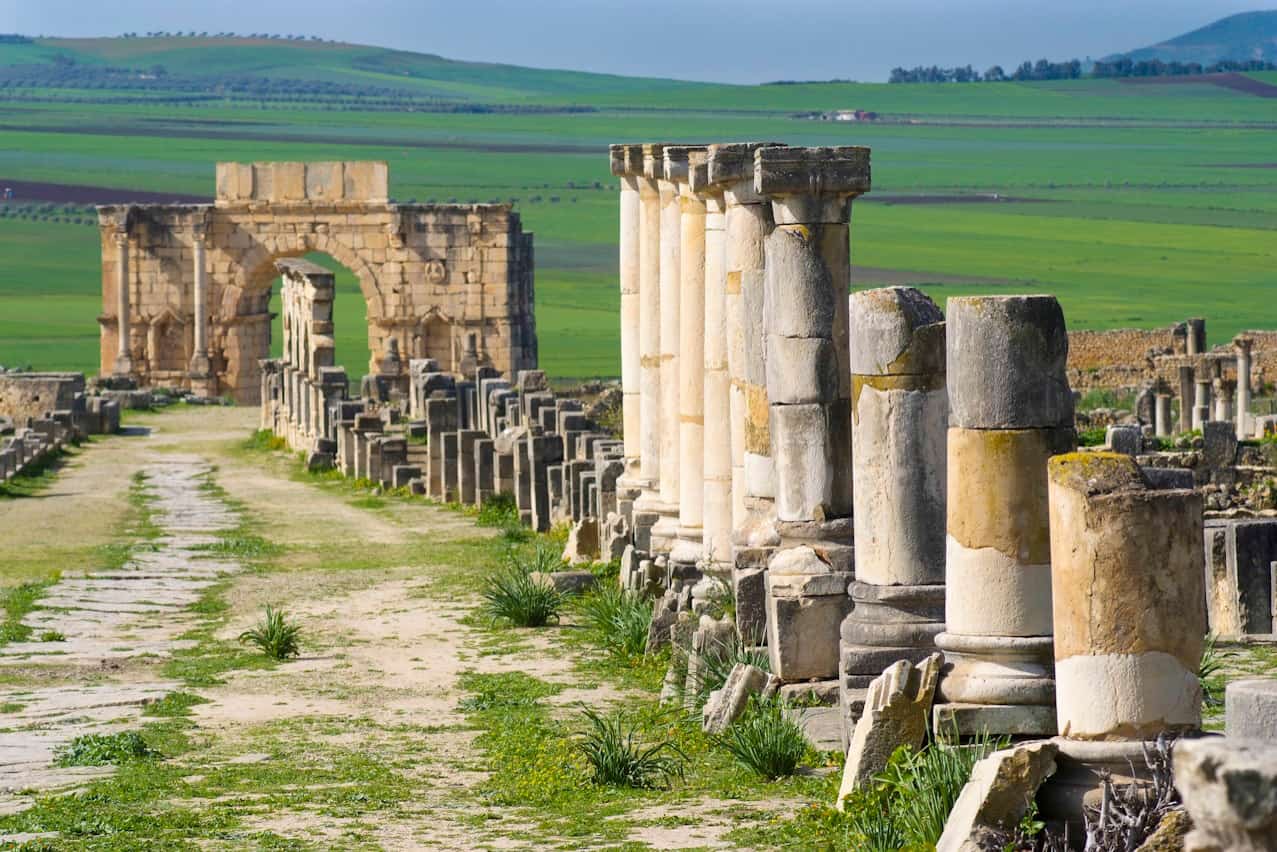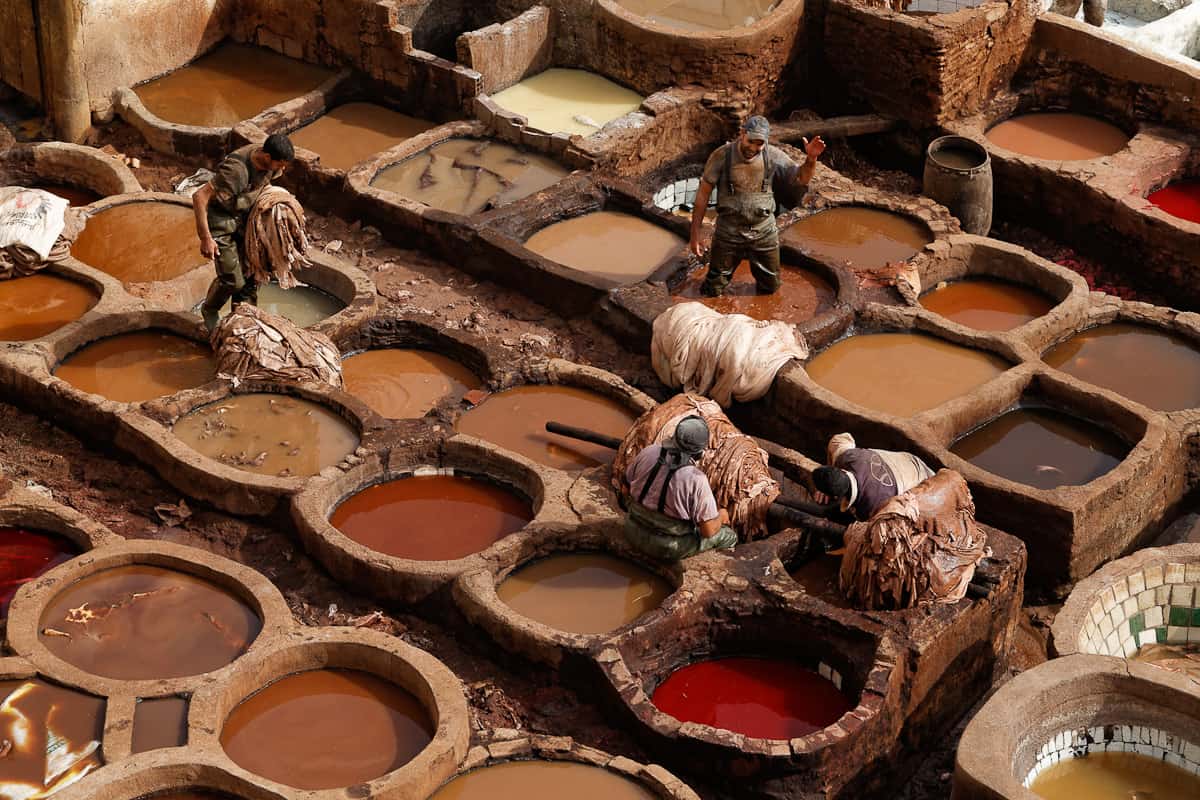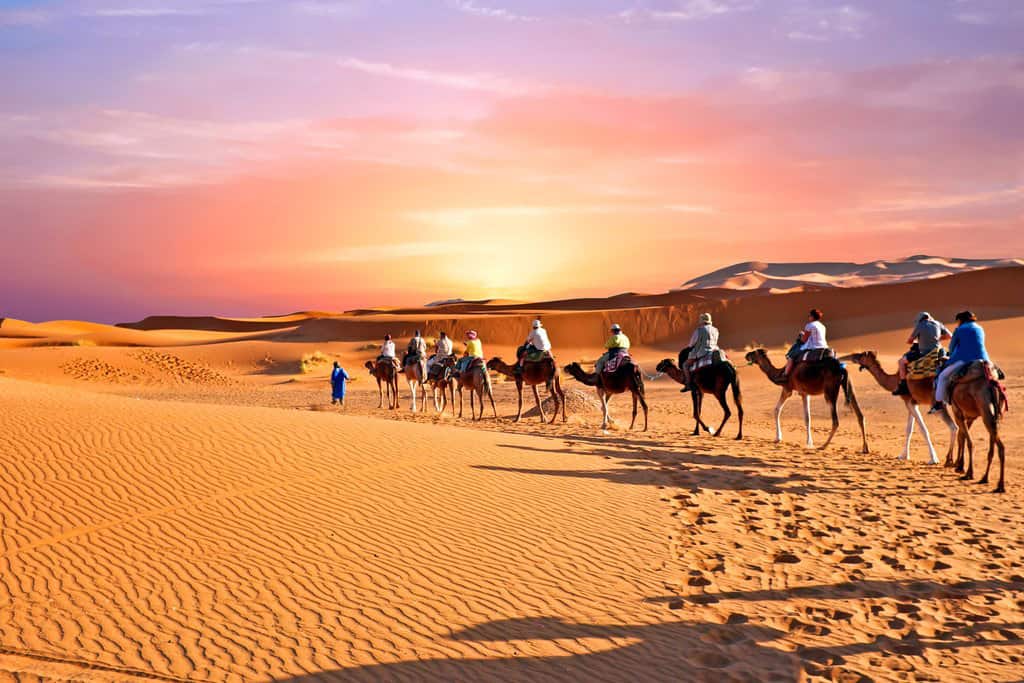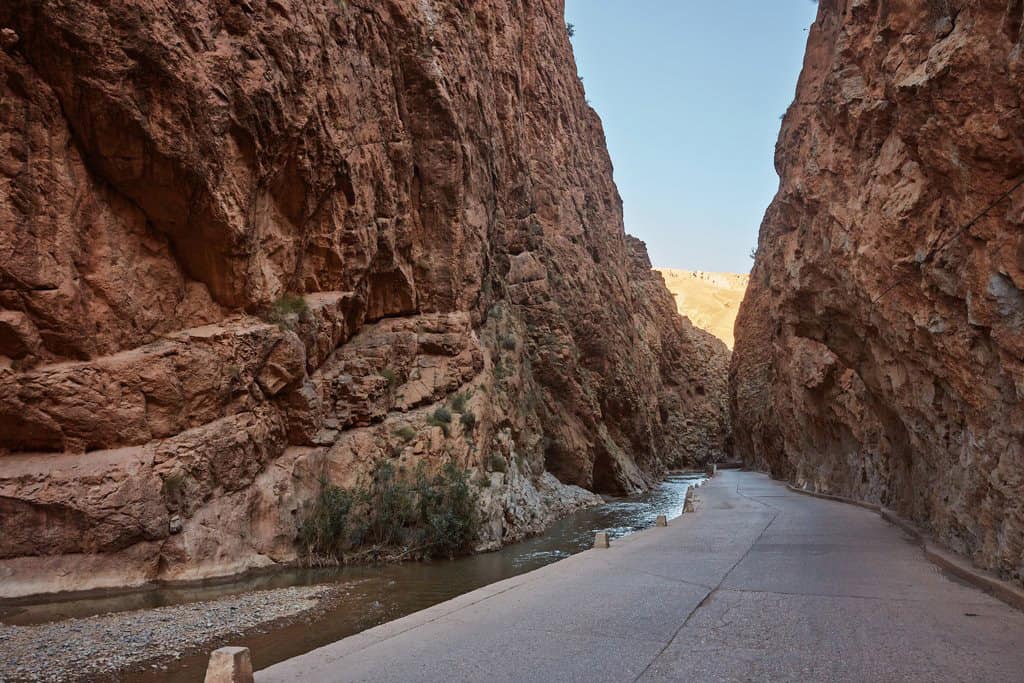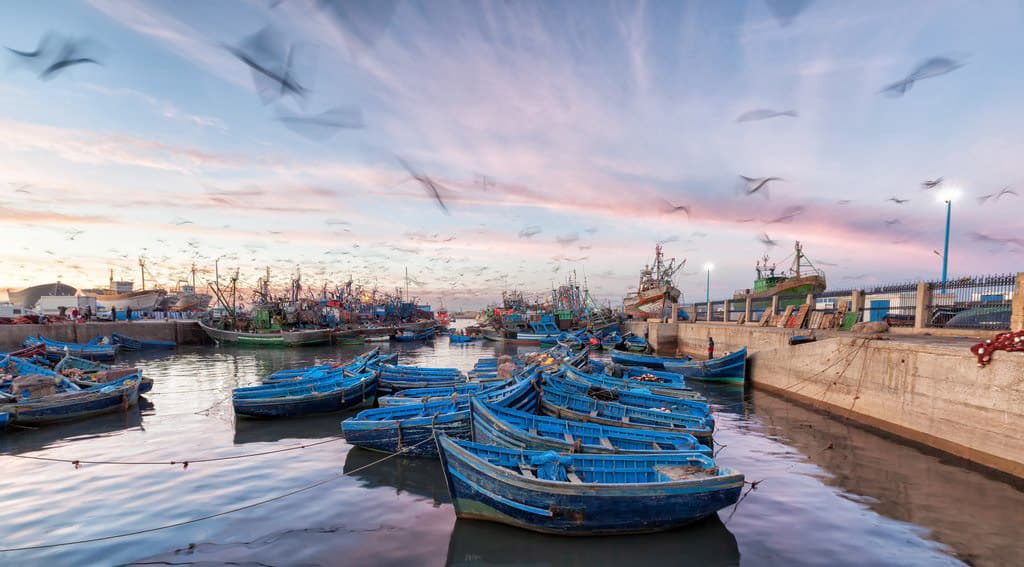The King-Hassan Tour
From Tangier
9 Days
Overview
This 9-day itinerary features a perfect mix of culture, history, adventure, and relaxation. Explore imperial cities, mountain villages, desert landscapes, and coastal ramparts. Begin in northern Morocco in Tangier and Chefchaouen before working your way south to Fes, through the desert, and over the Atlas Mountains to Marrakech and Essaouira.
Details & Itinerary
Day 1 – Tangier – Tetouan – Chefchaouen
Welcome to Tangier—the gateway between Europe and Africa! Located close to the south of Spain, visit the medina (old quarter), a café in the hip Zoco Chico square, or take a paseo to enjoy a stroll along the promenade. Or, travel straight on to the blue-washed city of Chefchaouen in the Rif Mountains. Enjoy the scenic route, stopping along the way to hike to the Cascades d’Akchou (Waterfalls of Akchour). Chefchaoen offers endless winding narrow streets and picturesque buildings. Find Plaza Outa el Hammam for a restaurant or café and enjoy a meal as you people watch. The Grand Mosque is still worth a visit. From there, explore the nearby kasbah (old fortification) and tour the garden, museum, and some of the old prison cells. Follow a path outside of the city walls to Hotel Atlas and climb to the rooftop to enjoy a panoramic view of the Blue City. For the slightly more athletic, follow the street east to pass over the Ras el Ma Spring and ascend the path (20-30 minutes) until you reach the abandoned white Spanish Mosque. Enjoy one last view over Chefchaouen as the sun sets behind the mountains. Dinner and overnight at your Riad / Hotel in Chefchaoune.
Day 2 – Chefchaouen – Roman Ruins of Volubilis and the imperial cities of Meknes and Fes
Rise early to snap photos of the people-less streets before leaving for Fes. Stop along the way at the UNESCO-protected Volubilis ruins—the Roman’s farthest reach in Africa. Wander the complex, exploring merchant homes with still-intact heating systems, temples, and many mosaics in situ. Continue on to the smaller, less busy version of Fes, Meknes, for an introduction to a historic imperial city. The two main points of interest are the Ville Impériale (Imperial City) and the medina. Be sure to visit the Bab al-Mansour gate, the Mausoleum of Moulay Ismail, and the Royal Stables. Continue on to Fes. With its impressively large (and somewhat confusing) old medina, Fes is a city worth getting lost in. Dinner and overnight at your Riad / Hotel in Fez.
Day 3 – Exploring the Imperial City and Medieval Medina in Fez
Fes is the oldest of the imperial cities in Morocco (Meknes, Marrakech, and Rabat are the others) and perhaps the most interesting to explore. A UNESCO-protected site, the city hasn’t undergone much colonial development, leaving you to experience its medieval charm. Fes consists of two old medina quarters, Fes el Bali (where you will spend most of your time) and Fes el Jdid (a slightly newer part of the city), and the early 20th-century French designed Ville Nouvelle. Meet your guide to help you navigate the narrow and maze-like ancient streets of the medinas, starting in Fes el Bali (789 CE).
Note the Spanish and Tunisian-influenced architecture as you pass the variety of souks (markets) offering spices, leather goods, and pewter. Known for its tanneries and the acrid smell associated with them, visit the popular Chouara Tannery and climb to the roof of a nearby shop for a better view of the goings-on. Visit the 14th-century Al Attarine Madrasa and admire the zellij tilework before checking out one of the oldest, still operating universities in the world, Al-Qarawiyyin University (859 CE). Find the Mellah (old Jewish quarter) in Fes el Jdid for another encompassing view of the city.
Before ending your guided tour in Fez, take the time to visit the Merenid Tombs located just north of the city and enjoy the all-encompassing view of historic Fes and the surrounding area. Descend the hill and return to your accommodation in Fez.
Day 4 – Fes- Ifrane – Cedar Forest – Atlas Mountains-Ziz valley-Merzouga- Erg Chebbi Dunes
Continue your journey south, over the Col du Zad pass (7,146 feet or 2,178 m) and through the cedar forests of the Middle Atlas mountains. You will see families of Barbary macaque monkeys in the trees and by the side of the road as you head to Midelt (the “apple city”) for lunch. Appreciate the scenery: the Moulouya River and the apple orchards. Next, travel over the Tizi n’Talremt pass and into the Ziz Valley dotted with oases and palm tree clusters. Notice the many ksars, fortified houses merchants built to protect their wares (gold, salt, and spices).
Nearing Erfoud, you will start to see the early signs of the Sahara sand dunes. Never stationary, the dunes travel as the winds shift. If you’re lucky, you may come across a nomadic Berber family and have the chance to drink tea together. Visit Erfoud and discover how the fossil-rich rock of its mines is transformed into decorative and practical objects. Continue on to the extensive sea of sand dunes of Erg Chebbi. Covering 13.5 square miles (35 square km), some dunes rise to over 656.2 feet (200 m), their color changing with the moving sun.
Outside of Merzouga, change the pace and prepare for a camel ride through the dunes, arriving at camp just before sunset. You will be welcomed with a mint tea before you mount upon camels and guided by an experienced camel man, to start your safari within the mysterious golden Morocco Desert. Return to camp for dinner in the open air and an evening by the campfire enjoying traditional Berber music from the locals under a blanket of stars. Spend the night in a Bedouin-style tent.
Day 5 –Adventures around Sahara Desert, Rissani Market & Todra Gorge -Tinghir – Dades Valley
Wake early to catch a desert sunrise, before trying your skill at sandboarding. You will also have the option of joining either an Erg Chebbi (sand dune) tour or an ATV tour. Visit nearby Khemliya, a traditional Saharan village, and experience traditional drumming music and dancing before taking a short walk around the village. Leave the dunes behind and stop in the market town of Rissani, entering through its impressive gate. Known for its livestock auction it’s worth your time finding the ‘donkey parking lot’ to delight your senses.
Continue on to Tinerhir. This desert town offers awesome views of neighboring towns hugging the length of the extensive river oasis (30 miles or 48 km of palm trees). Stop at today’s final destination, the Todra Gorge. 984 feet (300 m) high and carved by the Todra River through red limestone, here you can enjoy a leisurely walk in and around the gorge and relax in the cool waters of the shallow river below. Continue your morocco tour to the Dades Valley where you enjoy a quiet dinner overlooking the valley and spend an amazing overnight.
Day 6 –Dades Valley, Kelaat Mgouna – Ouarzazate & Aït Benhaddou Kasbah – Marrakech
Travel along the Valley of a Thousand Kasbahs to Morocco’s most famous kasbah, Aït Benhaddou. Pass through Kelâat M’Gouna to admire the rose bushes bordering plots of farmland. Visit a rose collectively to see the process of converting rose petals into rose water and oil. Continue west to stop in Ouarzazate and discover how its nearby regions have been featured in movies, including Lawrence of Arabia, Gladiator, and Black Hawk Down. Visit the famous Taourirte Kasbah, join a movie studio tour and visit the Musée du Cinema to learn more about the filmmaking process and history of the area. Continue to nearby Aït Benhaddou. A UNESCO World Heritage site, the old ksar dates from the 11th century when it held an important position along the trans-Saharan trade route. Settle into your accommodation in the old town, before wandering the near-empty alleys and passageways in the late afternoon. Climb up to the old Granary—an excellent vantage point to see the kasbah and surrounding area. Game of Thrones fans may want to trek down to the river to see the gates featured in the popular HBO series. Leave Aït Benhaddou behind to begin the ascent over the High Atlas mountains. Spot Mount Toubkal, the mountain range’s highest peak, at 13,671 feet (4,167 m). Near the top, stretch your legs for a great panoramic view of the mountains. Stop in Taddert to visit an Argan Oil Cooperative and learn, as well as sample, how olives are processed for various uses. As you descend the High Atlas, you will notice a dramatic change in the climate and landscape. Soon you will be a part of the noise and clamor of Marrakech. After a long day, spend the evening in the main square—and busiest square in all of Africa!—Jemaa el-Fna, comes alive with musicians, performers, snake charmers, games, and food stalls, a catch-all of entertainment! If you want to enjoy the spectacle from a distance, choose one of the many cafés surrounding the square and enjoy a cup of mint tea and a meal.
Day 7 – Marrakech: Explore the Red City
Nicknamed the “Red City” for its 1000-year-old red sandstone city walls and buildings, Marrakech has always been a thriving city dating back to the Berber Empire (1062 ACE). Meet your guide for a full-day tour, starting with browsing the stalls of Souk el Attarin (spices), Souk Haddadine (blacksmiths), and Souk Smata (slippers). Visit Souk des Teinturiers (the dyers’ souk) and visit the Koutoubia Mosque, along the way note the open spaces that extend off of some alleys. These fondouks were once medieval inns that provided travelers and merchants with shelter for themselves and their animals.
The hard-to-miss Mosque’s 253 feet (77 m) minaret is the tallest tower built in Marrakech. Relax in the adjoining gardens, before carrying on to Ben Youssef Madrasa. Built-in the 16th century, this madrasa once housed students of the nearby mosque. Admire the Moroccan artisanship: carved cedar, stucco plaster, and zellij tiling. Visit the Marrakech Museum or the Museum of Moroccan Arts for more examples of traditional art and woodwork. South of Jemaa el-Fna is the Kasbah area with several worthwhile sights: the Saadian Tombs, El Badi Palace, Bahia Palace, and the Jewish Mellah and cemetery. In the afternoon visit the Majorelle Gardens. Not far from the bustle of the medina, wandering the gardens filled with sub-tropical plants, bamboo, and lilies. Dinner and overnight in a deluxe Hotel / Riad.
Day 8 –An Enchanting Day Trip To Essaouira
After Breakfast at the accommodation, head west to the coastal town of Essaouira (approximately 5 hours). The name Essaouira means image, which is appropriate since it’s such a picturesque town. Its charm is undeniable; within the stone ramparts, you’ll find whitewashed houses with bright blue shutters, art galleries, and wood workshops. Today, join a local guide for a walking tour through the old medina, Jewish Mellah, port, and Skala (sea wall). Afterward, enjoy free time for the rest of the day. Maybe grab a freshly-cooked plate of the day’s catch at the port, or browse the plentiful shops and intriguing art galleries.
In the afternoon, we will drive back to the red city of Marrakech. If you’d prefer to relax, don’t miss the opportunity to indulge in a hammam or local-style bath. Dinner & overnight in Marrakech.
Day 9 –From Marrakech To the Airport in Marrakech-RAK or Casablanca-CMN
A direct transfer to the airport in Marrakech or Casablanca to do your check-in and registration in a good time for taking your flight home with a good experience and best memories about Morocco.
Tour Itinerary
Day 1–Tangier – Tetouan – Chefchaouen
Day 2 – Chefchaouen – Roman Ruins of Volubilis and the imperial cities of Meknes and Fes
Day 3 –Exploring the Imperial City and Medieval Medina in Fez
Day 4 –Fes- Ifrane – Cedar Forest – Atlas Mountains-Ziz valley-Merzouga- Erg Chebbi Dunes
Day 5–Adventures around Sahara Desert, Rissani Market & Todra Gorge -Tinghir – Dades Valley
Day 6–Dades Valley, Kelaat Mgouna – Ouarzazate & Aït Benhaddou Kasbah – Marrakech
Day 7–Marrakech: Explore the Red City
Day 8–An Enchanting Day Trip To Essaouira
Day 9–From Marrakech To the Airport in Marrakech-RAK or Casablanca-CMN.
What’s Included
Planning and quality control by seasoned travel leaders
Knowledgeable Guides (Multi-lingual), special lectures, and insightful meetings
Entrance Fees to Historic Monuments
All Transfers-even individual airport transfers, when required.
Luggage Handling-at all hotels, airport, etc.
Air-Conditioned, comfortable, and luxurious vehicles depending on your choice (4*4, Mini-bus…).
Nights at the top range hotels, Riads, Kasbahs, and Bivouacs.
Elegant Meals (Breakfast daily, and usually either Dinner).
All details are handled by reliable, experienced Tour Leaders.
Outstanding value and convenience.
No hidden add-ons or markup.
What’s Excluded
Lunchs
Tips
Travel insurance charges
Travel Advices
_
_
Best time to visit Morocco
The climate in Morocco varies wildly according to the season and area of travel. In the lowlands, the cooler months from October to April are popular among visitors. This time of year is pleasantly warm to hot (around 30°C) during the day and cool to cold (around 15°C) at night. Winter in the higher regions often brings snow and can therefore get seriously cold, particularly at night. Tourists flock to the coastline from June to September for fun in the sun, with warm mostly rain-free days. Further inland it can get hot and rain is rare, which makes the best times to travel March to June and September to December.
Morocco Culture & Customs
Morocco's culture has developed over centuries of influence from far and wide. Contemporary Morocco is a fascinating mix of Berber, Mediterranean, Andalucian, and African traditions, which are present in the cuisine, clothing, music, language, customs, and lifestyle. As an Islamic country, most Moroccans are Muslim; however, there are small populations of people who practice Judaism and Christianity. Classic examples of Islamic architecture can be observed all throughout the country and tenets of the Islamic religion are carried out in the customs and lives of the people. The 'Call to Prayer' can be heard five times a day, women are expected to dress modestly and alcohol isn't drunk by most of the population.
Most of Moroccan society can be considered traditional, with respect for elders, connection to family, and giving alms to the poor hallmarks of everyday life for many Moroccans. Hospitality is another important element of society, with warmly welcoming people into your home a time-honored tradition and social responsibility that dates back centuries.
Vegetarian and Vegan Options in Morocco ?
Much of Morocco's cuisine revolves around meat, but vegetables are an important staple and a crucial ingredient in many dishes of the Maghreb. Your diet can consist of more than just flatbread and hummus – trust us. Keep an eye out for vegetable-based tagines and couscous, the renowned Zaalouk (a smokey eggplant and tomato salad), vegetable Briouats (triangular-filled pastries), and cinnamon oranges. Vegan options are slightly more limited, as many of the pieces of bread and couscous dishes have butter added to them, but your best bet is to enquire if yours can be made using oil instead. Otherwise, it's easy to dine well on varied vege offerings in Morocco.



